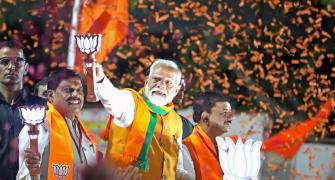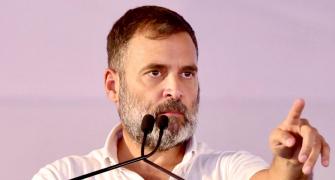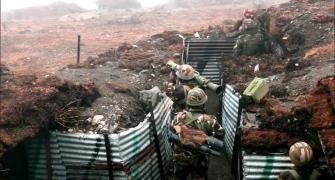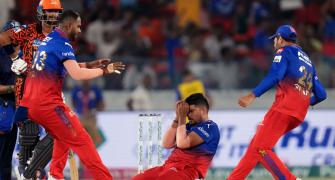Karnataka seems to be headed for yet another fractured mandate. If exit polls are to be believed, then it seems that no party will get the magical 112 figure in the 224-member Karnataka Legislative Assembly.
On May 25 after the counting of votes are over, if the verdict is split, then without a doubt, Karnataka will have yet another coalition government.
Coalitions in Karnataka are a relatively new concept. The first real coalition was formed only in 2004 by the Congress and the Janata Dal-Secular with N Dharam Singh as the chief minister. After this government fell, the JD-S joined hands with the Bharatiya Janata Party and formed the government with H D Kumaraswamy as the chief minister.
Karnataka has seen a government being formed by two parties in 1983. Poll pundits, however, say that it could not be termed as a coalition in the real sense.
The government in 1983 headed by Ramkrishna Hegde of the Janata Party was formed with the Kranti Ranga, which was then headed by S Bangarappa.
This government had the outside support of the Jan Sangh, which is now the BJP. The people of Karnataka, however, could not differentiate between the Janata Party and the Kranti Ranga as both parties fought the elections under the same symbol -- a farmer holding a plough.
However, this government which incidentally was the first non-Congress government in Karnataka, did not last long. As differences cropped up between Bangarappa and R K Hegde, the latter decided to go to the people and seek a fresh mandate.
The other instance where a party took support to form a government was when Karnataka was called the state of Mysore. The Congress led by K C Reddy had taken the support of three MLA's (two independents and one from the Muslim League) and formed the government.
When the first real coalition government in Karnataka was formed in 2004 with both partners actively taking part in the government, the people watched with anticipation as how this new concept would work for Karnataka.
However, the people were let down twice between 2004 and 2007. First the Congress was pulled down and then it was the chance of the BJP. Interestingly on both occasions, it was the JD-S which played party pooper.
The JD-S, which was the third largest party in Karnataka in 2004, had formed the government twice, thus making the people to re-think whether elections had any meaning.
There has been a lot of talk about stability after the tenure of the previous governments in 2004 ended abruptly. The Congress has been going to town talking about stability. The BJP, on its part, is confident of an absolute majority, while the JD-S maintains that none can form a government without its support.
Speaking about stability, it would be interesting to note here that since the year 1952 when the first elections in Karnataka took place (then known as the State of Mysore), only two chief ministers have managed to complete their entire term.
Devraj Urs, who led the Congress to power in 1972, remained in power for five years. He also managed to get a one year extension thanks to a amendment to the Constitution during emergency.
S Nijalingappa, another chief minister from the Congress managed to complete his term between 1962 to 1967.
However, technically speaking, he fell short of the complete five year term by three months as he was elected in a byelection, three months after the government had been formed.
S M Krishna who formed the government with a thumping majority in 1999 too fell short by four months as he decided to go the A B Vajpayee route and declare early elections. There have been a host of other chief ministers from Karnataka who have not managed to complete their terms.
From the Congress, there are the likes of Kengal Hanumanthraya Gundu Rao, Veerendra Patil, Veerappa Moily, S Bangarappa (now Samajwadi Party), N Dharam Singh.
The Congress, which had won the elections in 1989 with a thumping 180 seats in the 224 member house, saw three chief ministers in five years. Veerendra Patil, S Bangarappa and Veerappa Moily all ruled for a short span between 1989 and 1994. Interestingly after Veerendra Patil was shunted out one year after taking over as chief minister, the state was put under President's rule for seven days.
The other government which has tasted power in Karnataka before the 2004 elections is the Janata Party, which later broke into various branches, one being the JD-S too. However this non-Congress government too cannot claim that it has had chief ministers completing their term.
Ramkrishna Hegde was the chief minister between 1983 and 1988, but the term was not continous. His first and second term lasted a year each, while the third term gave him two years as chief minister. He was succeeded by S R Bommai who managed a one year term.
The only other non-Congress chief minister who looked like completing his term was H D Deve Gowda of the JD-S.
However after a 16 month rule, he was made the prime minister of the country following which J H Patel took over the mantle and completed the remainder of the term between 1996 and 1999.
In the year 1999, it was a Congress show with S M Krishna taking over as chief minister. However, he dissolved the House and went in for elections four months before the completion of his tenure.
The 2004 scenario is not new. Between 2004 and 2007, Karnataka has seen three chief ministers. N Dharam Singh of the Congress between May 2004 and January 2006, H D Kumaraswamy of the JD-S between February 2006 and October 2008 and finally B S Yeddyurappa of the BJP between November 12 to November 19, 2007.
Despite having heard so many horror tales about the various governments in Karnataka, why is it that the voter continues to hand out a hung verdict.
Poll pundits feel that the people are in with a tough choice. The poll surveys itself show that the favourite chief minister is not from the favourite party. In the Congress they look for stability while in the BJP they look for development.
As far as the JD-S is concerned, they look at H D Kumaraswamy who has become very popular among the masses of Karnataka especially in the rural belt.
If Karnataka is heading the coalition way once again, it looks likely that that the Congress and the JD-S will form the government.
Although both parties do not admit in the open about this fact, it is a well known fact in political circles that these two parties will join hands to keep the BJP away. Both the Congress and the JD-S realise that the BJP is trying hard to set foot in south India and every effort is being made to snatch this moment of glory from the BJP.
Poll predictions:
Suvarna Channel:
BJP: 104-114
Congress: 69-74
JD-S: 35-40
Others: 6-10
CNN-IBN
BJP: 86
Congress: 79
JD-S: 45
Others- 14
NDTV
BJP: 95-115
Congress: 55-75
JD-S: 45-55
Others: 10-15
How Karnataka has voted? (Figures in terms of poll percentage)
1952: 43.65 (Congress)
1957: 52.08 (Congress)
1962: 50.22 (Congress)
1967: 48.43 (Congress)
1972: 53.38 (Congress)
1978: 46.38 (Congress)
1983: 40.89 (Janata Party)
1985: 41.05 (Janata Party)
1989: 44.27 (Congress)
1994: 34.02 (Janata Dal)
1999: 41.15 (Congress)
2004: 31.68 (BJP)








